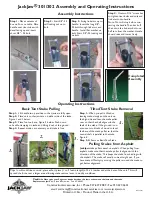
Subject to change without notice
11
Sometimes the trace will disappear after an input signal
has been applied. The attenuator switch must then be
turned back to the left, until the vertical signal height is
only 3-8div. With a signal amplitude greater than 160V
pp
,
an attenuator probe must be inserted before the vertical
input. If, after applying the signal, the trace is nearly
blanked, the period of the signal is probably substantially
longer than the set value on the
TIME/DIV.
switch. It
should be turned to the left to an adequately larger time
coefficient.
The signal to be displayed can be connected directly to
the Y-input of the oscilloscope with a shielded test
cable such as HZ 32 or HZ 34, or reduced through a x10
or x100 attenuator probe. The use of test cables with
high impedance circuits is only recommended for
relatively low frequencies (up to approx. 50 kHz). For
higher frequencies, the signal source must be of low
impedance, i.e. matched to the characteristic resistance
of the cable (as a rule 50 Ohm). Especially when
transmitting square and pulse signals, a resistor equal
to the characteristic impedance of the cable must also
be connected across the cable directly at the Y-input of
the oscilloscope. When using a 50
Ω
cable such as the
HZ 34, a 50
Ω
through termination type HZ22 is available
from HAMEG. When transmitting square signals with
short rise times, transient phenomena on the edges
and top of the signal may become visible if the correct
termination is not used. A terminating resistance is
sometimes recommended with sine signals as well.
Certain amplifiers, generators or their attenuators
maintain the nominal output voltage independent of
frequency only if their connection cable is terminated
with the prescribed resistance. Here it must be noted
that the terminating resistor HZ22 will only dissipate a
maximum of 2 Watts. This power is reached with 10
Vrms or at 28.3 V
pp
with sine signal.
If a x10 or x100 attenuator probe is used, no termination
is necessary. In this case, the connecting cable is matched
directly to the high impedance input of the oscilloscope.
When using attenuators probes, even high internal
impedance sources are only slightly loaded (approx. 10
M
Ω
II 16 pF or 100 M
Ω
II 9 pF with HZ 53). Therefore, if
the voltage loss due to the attenuation of the probe can be
compensated by a higher amplitude setting, the probe
should always be used. The series impedance of the
probe provides a certain amount of protection for the input
of the vertical amplifier. Because of their separate
manufacture, all attenuator probes are only partially
compensated, therefore accurate compensation must be
performed on the oscilloscope (see “Probe compensation
page M7).
Standard attenuator probes on the oscilloscope normally
reduce its bandwidth and increase the rise time. In all
cases where the oscilloscope bandwidth must be fully
utilized (e.g. for pulses with steep edges) we strongly
advise using the
modular probes HZ 51
(x10)
HZ 52
(x10
HF) and
HZ 54
(x1 and x10. This can save the purchase
of an oscilloscope with larger bandwidth and has the
advantage that defective components can be ordered
from HAMEG and replaced by oneself. The probes
mentioned have a HF-calibration in addition to low
frequency calibration adjustment. Thus a group delay
correction to the upper limit frequency of the oscilloscope
is possible with the aid of an 1MHz calibrator, e.g. HZ60.
In fact the bandwidth and rise time of the oscilloscope are
not noticably changed with these probe types and the
waveform reproduction fidelity can even be improved
because the probe can be matched to the oscilloscopes
individual pulse response.
If a x10 or x100 attenuator probe is used, DC input
coupling must always be used at voltages above
400V
. With AC coupling of low frequency signals, the
attenuation is no longer independent of frequency,
pulses can show pulse tilts. Direct voltages are
suppressed but load the oscilloscope input coupling
capacitor concerned. Its voltage rating is max. 400 V
(DC + peak AC).
DC
input coupling is therefore of quite
special importance with a x100 attenuation probe which
usually has a voltage rating of max. 1200 V (DC + peak
AC). A
capacitor
of corresponding capacitance and
voltage rating may be connected in
series with the
attenuator
probe input for blocking DC voltage (e.g. for
hum voltage measurement).
With all attenuator probes, the
maximum AC input voltage
must be
derated
with frequency usually above 20kHz.
Therefore the derating curve of the attenuator probe type
concerned must be taken into account.
The selection of the ground point on the test object is
important when displaying small signal voltages. It should
always be as close as possible to the measuring point. If
this is not done, serious signal distortion may result from
spurious currents through the ground leads or chassis
parts. The ground leads on attenuator probes are also
particularly critical. They should be as short and thick as
possible. When the attenuator probe is connected to a
BNC-socket, a BNC-adapter, which is often supplied as
probe accessory, should be used. In this way ground and
matching problems are eliminated.
Hum or interference appearing in the measuring circuit
(especially when a small deflection coefficient is used) is
possibly caused by multiple grounding because equalizing
currents can flow in the shielding of the test cables
(voltage drop between the protective conductor
connections, caused by external equipment connected to
the mains/line, e.g. signal generators with interference
protection capacitors).












































